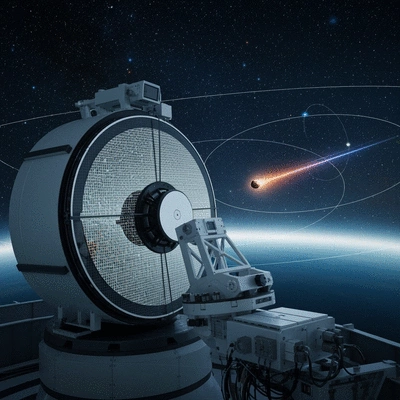What if I told you that understanding asteroids could unlock secrets about our origins and the future of space exploration? The recent discovery of 2025 SC79 is a prime example of how these celestial bodies can reshape our understanding of the universe.
What You Will Learn
- 2025 SC79 is the second-fastest recorded asteroid, highlighting the need for advanced tracking methods.
- As an Atira asteroid, its orbit lies entirely between Earth and Venus, complicating detection efforts.
- Researching 2025 SC79 offers critical insights into the behavior and risks associated with near-Earth objects (NEOs).
- International collaborations are essential for improving detection techniques and studying asteroids effectively.
- Understanding asteroids like 2025 SC79 has implications for future space exploration, resource utilization, and planetary safety.
- Asteroids may contain essential elements, such as water and organic compounds, pivotal for understanding life's potential in the cosmos.
Key Characteristics & Significance of Asteroid 2025 SC79
2025 SC79 is a rare Atira asteroid, notable for its extreme speed and unique orbit entirely within Earth and Venus. Its study is vital for understanding Near-Earth Objects (NEOs) and planetary defense.
Speed & Classification: Second-Fastest Atira Asteroid
2025 SC79 is the second-fastest asteroid ever recorded. Its classification as an Atira asteroid means its orbit is entirely within Earth's and Venus's orbits, making detection challenging but crucial for planetary defense.
Orbital Challenges: Obscured by Sun's Glare
Its orbit within Venus's path makes 2025 SC79 difficult to detect due to the Sun's glare. This emphasizes the need for advanced observational strategies and technological advancements in astronomy.
NEO Insights: Data for Predictive Models & Impact Studies
Studying 2025 SC79 provides crucial data for predictive models, helping scientists assess potential impact scenarios of similar Near-Earth Objects (NEOs) and inform planetary defense.
Future Implications: Space Exploration & Astrobiology
Asteroids like 2025 SC79 offer insights into solar system formation, potential space resources (e.g., water ice), and organic compounds, thus contributing to astrobiology and future exploration.
Understanding the Discovery of 2025 SC79 and Its Significance
The discovery of 2025 SC79 marks a pivotal moment in our understanding of asteroids. As the second-fastest asteroid recorded, it speeds through space at remarkable velocity, making scientists eager to learn more about its characteristics. Additionally, this asteroid is classified as an Atira asteroid, which means its orbit lies entirely within that of Earth and Venus. This classification is significant because it highlights the unique nature of 2025 SC79 and why it commands our attention in the realm of space exploration.

Understanding its size and outline helps astronomers grasp the risks associated with near-Earth objects (NEOs). With an impressive diameter, 2025 SC79 has captured the interest of researchers who are keen to explore not just its physical attributes, but also the implications of its orbit and behavior.
What is 2025 SC79 and Why is it Notable?
- Speed: 2025 SC79 is the second-fastest asteroid ever recorded, moving at extraordinary velocities.
- Size: This asteroid is sizable enough to warrant careful observation and study.
- Classification: As an Atira asteroid, its unique orbit presents challenges for detection.
These traits contribute to its significance in ongoing asteroid research. The speed alone poses challenges for astronomers attempting to track its path, while its classification presents opportunities to expand our understanding of the dynamics of NEOs.
The Unique Orbit of 2025 SC79 and Its Challenges
The orbit of 2025 SC79 is particularly intriguing as it lies within the orbit of Venus, complicating detection efforts. This unique positioning means that detecting it requires advanced observational strategies since it spends much of its time obscured by the Sun’s glare. As a result, astronomers face considerable challenges when attempting to monitor its path.
This difficulty in visibility emphasizes the importance of technological advancements in the field of astronomy. The implications of these challenges are far-reaching, impacting not only how we observe asteroids but also our understanding of their potential risks. The more we know about these celestial bodies, the better we can prepare for any possible encounters with Earth, particularly those hidden in the Sun's glare.
The Role of 2025 SC79 in Understanding Near-Earth Objects (NEOs)
Studying 2025 SC79 provides critical insights into the broader category of near-Earth objects (NEOs). By examining its orbit, speed, and composition, we can learn more about the potential interaction of similar asteroids with our planet. These studies help determine impact probabilities and potential consequences for Earth.
- Data Collection: Observations of 2025 SC79 contribute valuable data for predictive models.
- Impact Studies: Understanding its characteristics allows scientists to assess potential impact scenarios.
- Public Awareness: Increased knowledge of NEOs raises awareness about planetary defense initiatives.
This asteroid, while just one among many, serves as a crucial piece in the puzzle of understanding the behaviors and risks associated with NEOs. Each observation and analysis enhances our preparedness and response strategies as we look to safeguard our planet from potential threats.
Pro Tip
Did you know? Staying informed about asteroids like 2025 SC79 can help you understand the broader implications of near-Earth objects. Consider following space agencies such as NASA or ESA for real-time updates and discoveries. Engaging with their content can deepen your appreciation for the universe and the advancements in asteroid research!
Frequently Asked Questions About Asteroid 2025 SC79
- What is special about Asteroid 2025 SC79?
- 2025 SC79 is notable for being the second-fastest asteroid ever recorded. It is also an Atira asteroid, meaning its orbit lies entirely within Earth's and Venus's orbits.
- What is an Atira asteroid?
- An Atira asteroid is a type of asteroid whose entire orbit is contained within the orbit of Earth, typically also within Venus's orbit. These asteroids are challenging to detect because they often appear in the direction of the Sun.
- Why is 2025 SC79 difficult to detect?
- Its orbit being entirely within Venus's path means it is frequently obscured by the Sun's glare from Earth's perspective, requiring advanced observational strategies and technology for detection.
- How does studying 2025 SC79 help with planetary defense?
- Studying 2025 SC79 provides crucial data for predictive models, helping scientists assess potential impact scenarios of similar Near-Earth Objects (NEOs), thereby enhancing Earth's protection and preparedness.
- What are the implications of 2025 SC79 for space exploration and astrobiology?
- Asteroids like 2025 SC79 offer insights into solar system formation and may contain valuable resources like water ice and organic compounds. This contributes to astrobiology by providing clues about the origins of life and supports future space missions by identifying potential resource sources.
Looking Ahead: The Future of Asteroid Detection and Research
As we gaze into the cosmos, the future of asteroid detection and research is bright! At The Stone Builders Rejected, we believe it’s crucial to highlight the collaborative efforts of the scientific community in studying asteroids like 2025 SC79. These collaborations are fostering a deeper understanding of these celestial bodies, enhancing our preparedness for potential risks.
International partnerships are essential in pooling resources and expertise. Scientists are sharing data and insights, creating a more comprehensive approach to asteroid research. This collaboration includes:
- Joint observational campaigns using various telescopes.
- Data-sharing agreements to enhance analysis and monitoring efforts.
- Collaborative research projects that aim to improve detection techniques and models.

The collective knowledge from these efforts not only improves our understanding of asteroids but also helps in developing strategies to mitigate potential threats.
Implications for Space Exploration and Safety
Asteroid discoveries like 2025 SC79 have significant implications for both space exploration and planetary safety. As we advance our exploration capabilities, understanding asteroids becomes vital for future missions. The knowledge we gain can inform not just safety protocols but also resource utilization in space!
In addition to safety, the potential for mining asteroids is an exciting prospect. Here are some key implications:
- The possibility of sourcing materials for fuel and construction in space.
- Insights into the formation of the solar system, giving context to our own planet's history.
- Increased safety measures for future missions to ensure astronauts are protected from unforeseen asteroid encounters.
These considerations highlight how vital it is to continue asteroid research in the context of our growing ambitions in space exploration.
How Astrobiology and Asteroids Intersect
Asteroids are more than just rocky bodies; they might hold secrets about the origins of life! At The Stone Builders Rejected, we find the intersection of astrobiology and asteroids fascinating. Studying these celestial objects can reveal clues about the building blocks of life, particularly how organic materials can survive in space.
Asteroids could potentially harbor water ice and other essential elements. Here are some key points to consider:
- Asteroids may contain organic compounds that are fundamental for life.
- The presence of water on asteroids could support future human missions.
- Investigating asteroids helps us understand how life might exist elsewhere in the universe.
By exploring these possibilities, we not only learn about asteroids but also enhance our understanding of life's potential across the cosmos.
Recap of Key Points
Here is a quick recap of the important points discussed in the article:
- 2025 SC79's Speed: It is the second-fastest asteroid recorded, moving at extraordinary velocities.
- Unique Classification: As an Atira asteroid, its orbit lies entirely within that of Earth and Venus, presenting unique challenges for detection.
- Impact on NEO Research: Studying 2025 SC79 provides critical insights into near-Earth objects (NEOs) and helps assess potential impact scenarios.
- Technological Advancements: Enhanced observational strategies are essential for tracking asteroids like 2025 SC79 due to their unique orbits and visibility challenges.
- Collaboration in Research: International partnerships are crucial for pooling resources and improving detection techniques in asteroid research.
- Astrobiological Insights: Asteroids may hold secrets about the origins of life and essential resources such as water ice for future missions.





